Beef Mechado, Filipino Beef Stew
This Filipino version of classic beef stew doesn’t bother with wine–only a handful of the simplest ingredients are thrown in the pot–but it is deep in flavor and rich in comfort.
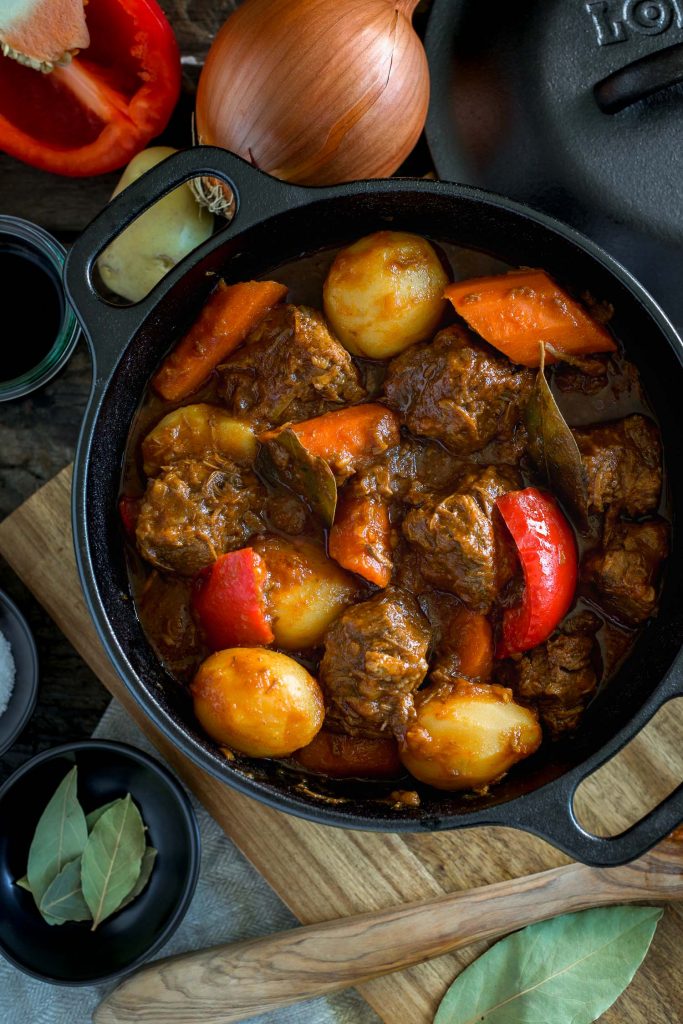
“Tè?!” she asked, not hiding the disapproval in her voice.
My husband and I were on the island of Lipari, one of the Aeolian islands above Sicily. It was the height of summer, the warm Mediterranean water was just a few steps away. In the middle of the afternoon I ordered hot tea. Even the patrons at the table next to me reacted to my unusual, apparently inappropriate request.
What can I say? I like my tea in the afternoon. In Europe the only iced tea usually available is Lipton in a can and while it is pleasant enough, I tend to like a stronger, unsweetened brew. This was almost 15 years ago, before I smartened up and figured out that I could simply ask for a glass filled with ice with my pot of hot, black tea so I can prepare my own.
All this to say that you are probably looking at this post and wondering why I’m sharing a recipe for what is traditionally a winter favorite. Stew? In April?
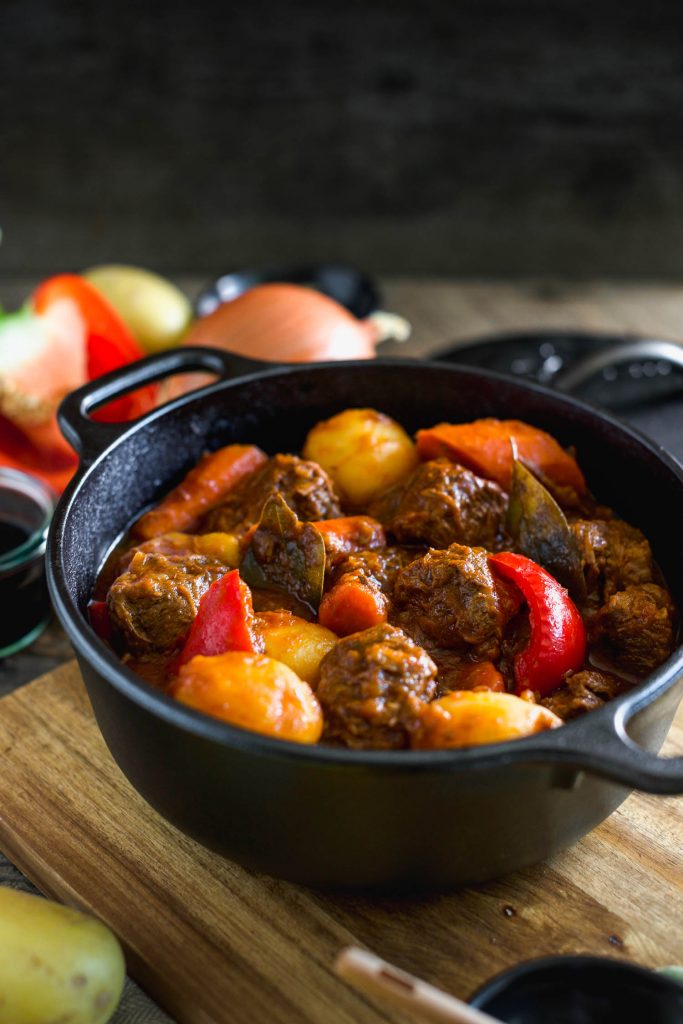
But to that I respectfully say, “Why not?”
Beef Mechado, a dish born during the islands’ Spanish colonial era, is one of the most popular dishes on the Philippine table. A tropical country like the Philippines doesn’t experience seasonal changes like we do here–there’s the wet season and the dry season and it doesn’t get much cooler than 75ºF with the exception of a handful of cities (Baguio, Tagaytay) where overnight lows can dip to a frigid 55ºF! The availability of some fruit and vegetables may be marked by seasons but most Filipino cooks will include adobo, afritada and sinigang–braised, stewed and soupy, respectively–as part of their cache of recipes and serve them year round. Add to this the fact that I grew up in San Francisco’s foggy summers and where average temperatures don’t vary too much during the year. So my eating habits are not always dictated by seasons.
This Asian version of a western classic is really not much different than what you may be used to. Humble ingredients are slowly simmered on the stove, rewarding with meltingly tender beef and rich, deeply-flavored sauce. The Asian touch comes from the use of soy sauce and lemon juice to add acidity, depth and body instead of red wine. While these two ingredients may seem strange in stew you might appreciate what they add to the finished dish. A good mechado should have that slow-cooked, hearty richness we all look for in a stew (and this one does); the lemon adds just enough brightness to keep this simple dish from tasting flat. I like to add a good amount of carrots to balance the acidity and round out the flavors. I’ve served this recipe to friends and family and even the non-Filipino crowd enjoys it. Rice is the traditional accompaniment but a good loaf of crusty bread would be just fine, too.

I’ve been remiss in sharing most of the Filipino dishes of my childhood and I vow to change that this year. As much as I love my big salads in spring and summer I can never stay away from hearty dishes like this for too long–even if it means eating the same dish for a week since I know only to prepare these recipes in large batches. But that’s a sacrifice I’m willing to make. Comfort food is always in season, right?
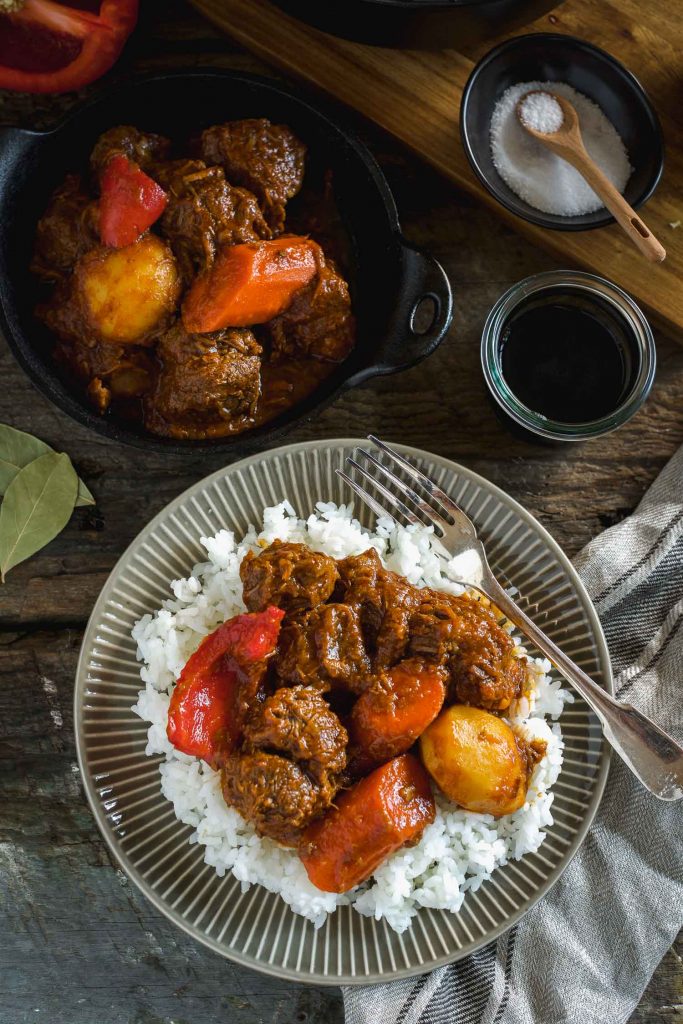
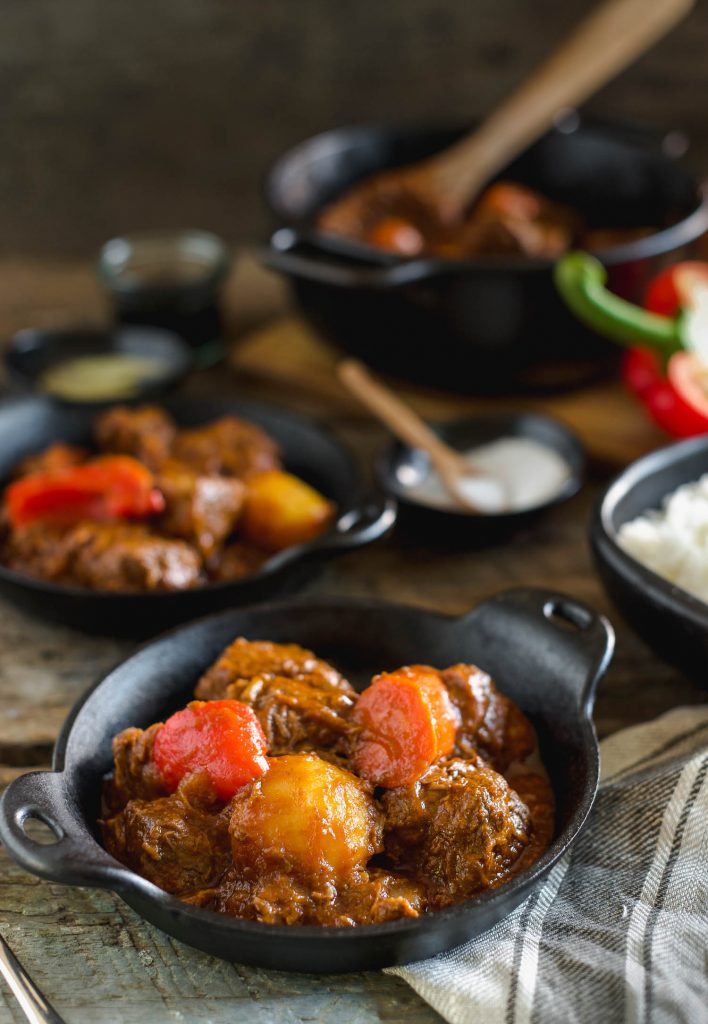
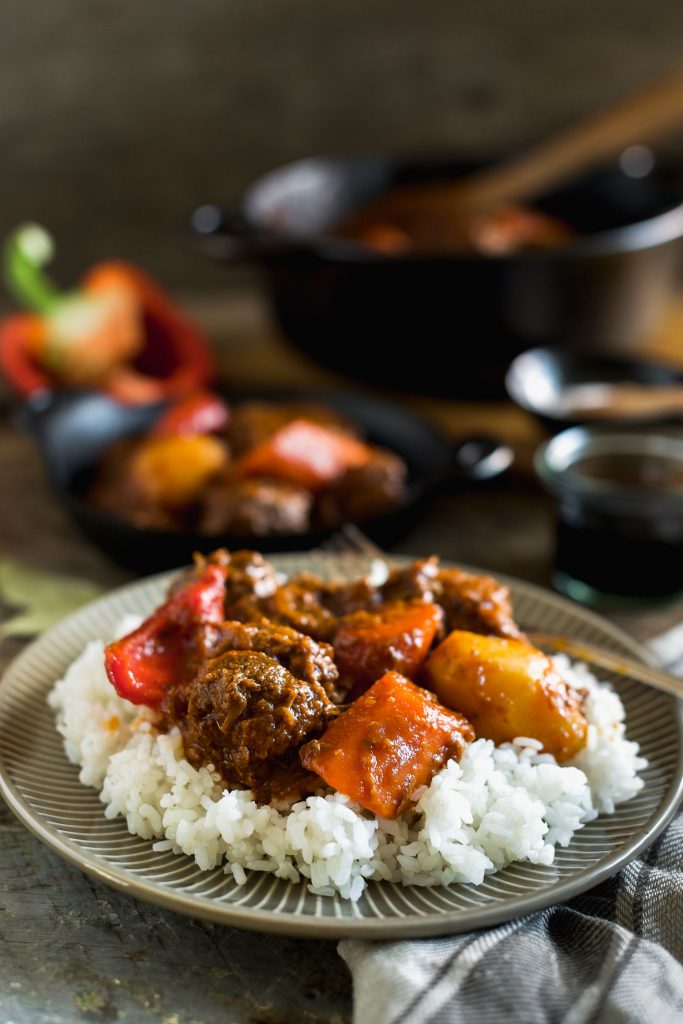
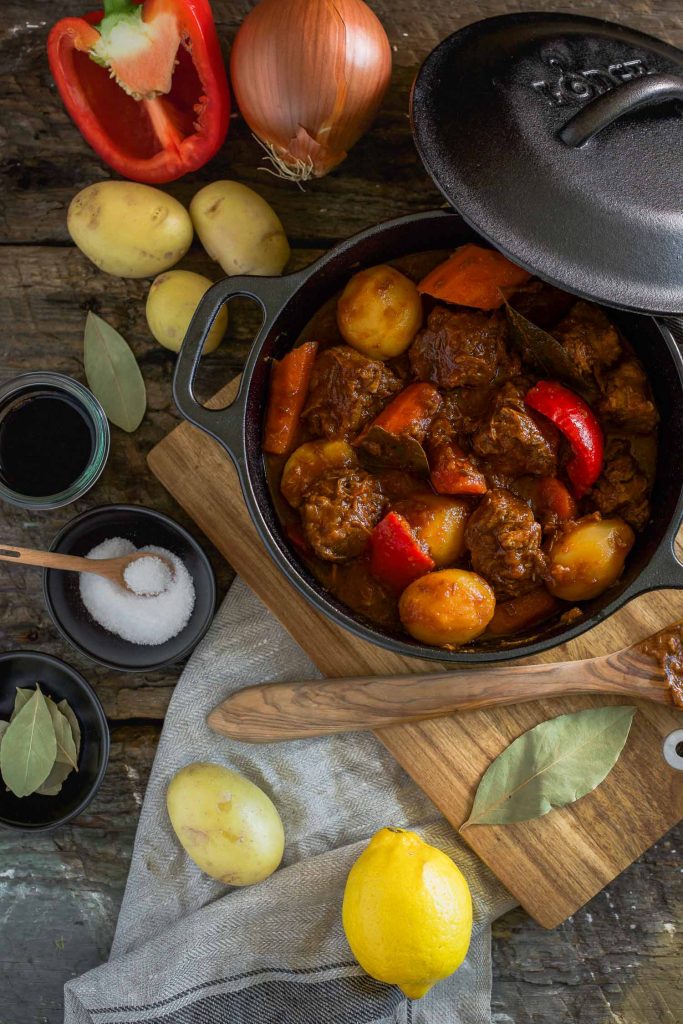

Beef Mechado, Filipino Beef Stew
Ingredients
- 3 1/4 - 3 1/2 pounds beef chuck cut in large cubes I trim the excess fat so I don't have to skim after cooking
- 5-6 tablespoons fresh lemon juice
- 1/4 cup soy sauce*
- 1 large onion roughly sliced
- 1 15 oz + 1 8oz can tomato sauce
- Beef Stock low sodium; 2/3 of the 15 oz tomato can; about 10 ounces**
- A few shakes garlic powder not garlic salt; roughly 1/2 teaspoon
- A few shakes onion powder not onion salt; roughly 1/2 teaspoon
- 2 dried bay leaves
- 3 medium to large carrots peeled and cut in large pieces
- 3/4 - 1 pound small potatoes or about three regular, peeled
- 1 red bell pepper cut in pieces
- Olive oil for cooking a few tablespoons
Instructions
Marinate the Beef:
-
In a large bowl combine the beef, lemon juice and soy sauce and marinate for 45 minutes to 1 hour. (NOTE: Do not discard the lemon/soy sauce marinade--this will go in the stew.)
Cook the Stew:
-
In a large pot or skillet heat two or three tablespoons of olive oil over medium-high heat. You'll be browning the beef in two to three batches. Take the marinated pieces from the bowl, draining the excess marinade and add to the pot with heated oil. Brown the beef, two to three minutes each on two sides then transfer to a plate while you brown the rest of the beef. Don't forget to save the marinade. Add another tablespoon of oil if you need it.
-
Once all the beef has browned, in the same skillet, reduce the heat to medium then add the onion, garlic powder and onion powder. Cook for two to three minutes. Add another tablespoon or two of oil if it's too dry. Use a wooden spoon or spatula to loosen the brown bits from the pan.
-
Next, add back to the pot the beef, all the reserved marinade along with the tomato sauce, beef stock (or water) and the bay leaves. Scrape the remainder of the bits stuck to the pan. Cover and bring to a boil.
-
As soon as the liquid starts boiling, cover again, lower the heat and simmer until the meat is tender. Stir occasionally to avoid any sticking. (Total simmer time will be about one and a half hours.) The stew will collect a lot of liquid and this is okay. If you prefer you can just partially cover the pot with the lid but stews like this thicken eventually (especially if you use more potatoes) so I don't mind the excess liquid as it cooks.
-
Add the carrots and potatoes 1 hr into the simmering time. If your sauce has thickened and dried up at this stage you can add a bit more stock or water, about 1/4 cup at a time, but I normally don't need to. Add the red bell pepper 20 minutes after you add the carrots and potatoes and simmer for an additional 10 minutes. The beef should be tender and the sauce thickened after an hour and a half.
-
Serve warm with rice or bread. This stew gets thicker and more flavorful as you reheat it. If you should have leftovers two or three days later it wouldn't hurt to add a bit more stock or water. It doesn't dilute the flavor.
Recipe Notes
*Soy Sauce: I use a mix of Filipino soy sauce and low sodium Kikkoman but feel free to use whatever soy sauce you have.
** You can use water instead of beef stock.






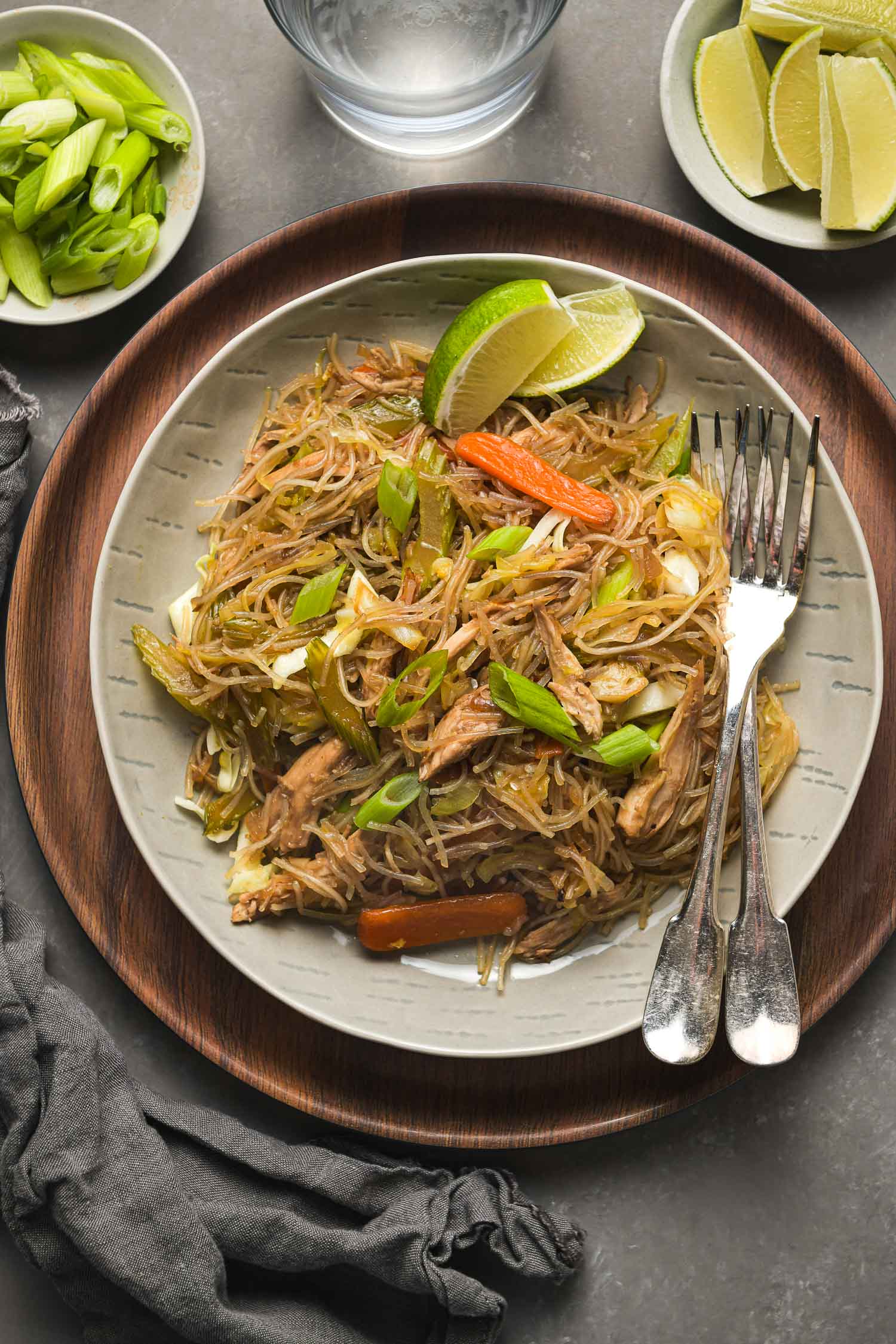
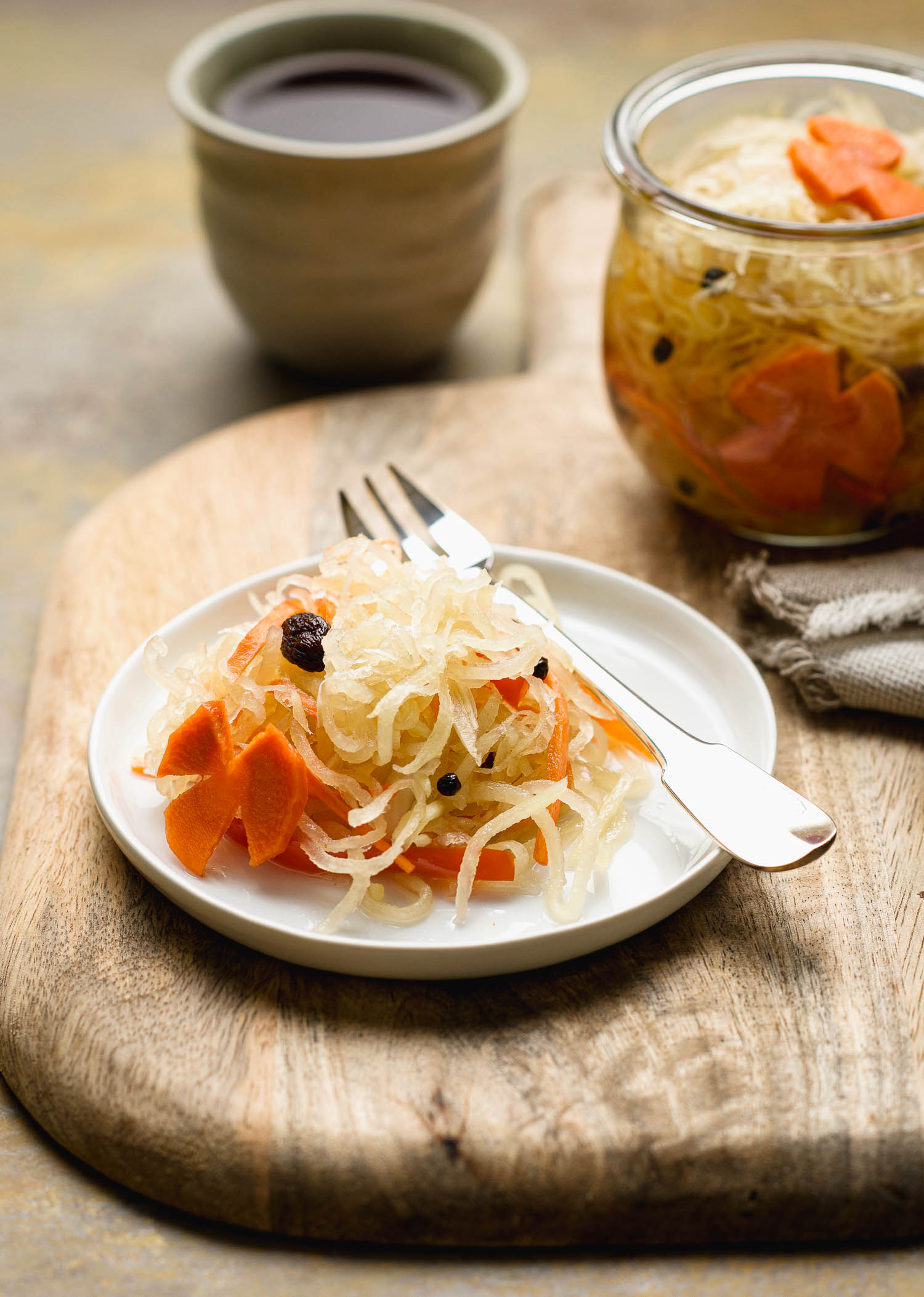
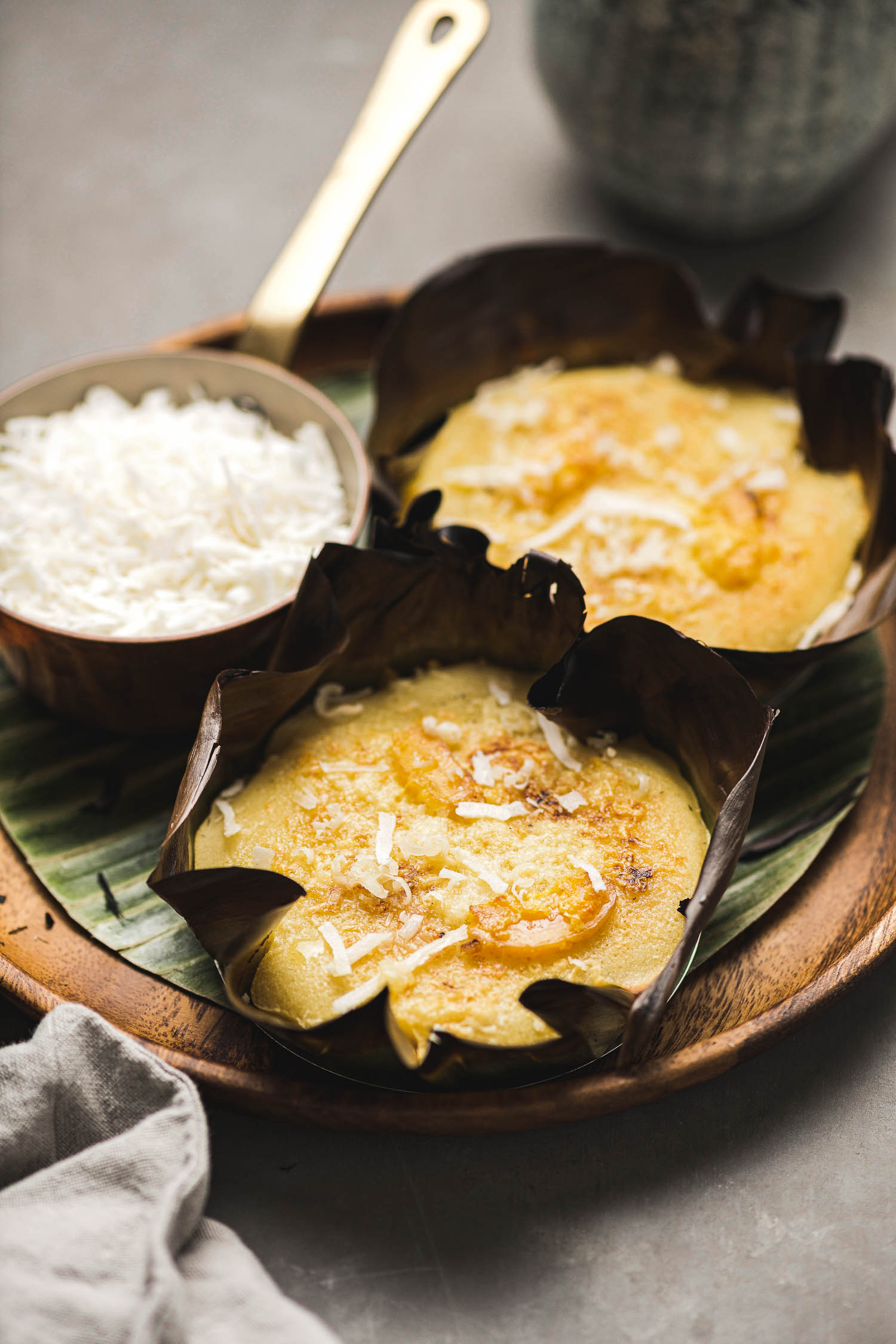

Yes and yes. I agree that comfort food is always in season and your machado is certainly no exception. And also yes to your tè habits. I too order plain strong black tea to make my own ice tea on vacation. GREG
Sounds great!
What delicious flavors, comfort food is always in season, and this would be great to try before the summer heat hits!
***
As long as it tastes good that’s what matters! Bon apetit!
Do you have a video version that I can watch ? Thank you, God Bless….
Hi, I’m sorry I don’t have any videos but it’s super easy to make mechado. Let me know if you need more assistance. 🙂
I’ve referred back to this recipe several times now when I make beef mechado because I just love it! Thanks for sharing. I did some adjustments and put half the amount of lemon. Adding a bit of sugar helps to balance out the flavors though!
Anna, your comment makes me so happy. I’m so glad you’ve decided to use this recipe as your base and have made it your own. Happy New Year!
This turned out great! Reminds me a lot of my mom’s version of mechado. It’s my ultimate comfort food.
I used this recipe as a base and threw in a splash of Worcestershire sauce to the marinade like my mom does and some additional types of veggies.
I added a little brown sugar as well. Made this recipe twice already!
Yay, Jessica! Thanks for giving this recipe a try and I’m so glad you were able to use it as a springboard for recreating your mom’s mechado. Thanks so much for this nice feedback! 🙂
Omg just made this tonight, it is INCREDIBLE and tastes just like my mom’s! Thank you so much for this amazing recipe. 🙂
Emily, so happy to hear this, yay! Thank you so much for your wonderful feedback! 🙂
Could I make this in a slow cooker? If so, how would you do it? Thanks so much. I can’t wait to try this recipe.
Hi, Mary. Yes, you can make this in a slow cooker but I haven’t made it in one myself. Typically you would brown the meat on the stovetop for color then add to the slow cooker with the tomato sauce and liquid. The vegetables would be added later since they need much less time to cook. Hope this helps. 🙂
when do i put the bell pepper?
Hi, Tiffany. You can add the bell pepper maybe 10 minutes before the end of the cooking time. 🙂
Made it last night and was a hit! Coming from someone who doesn’t cook often, this was easy and straightforward
Yay, this is so nice to hear, Jay. Glad the recipe worked out for you and thanks so much for giving it a chance! 🙂
How much beef stock? Unclear direction on beef stock.
Hi Mark, it’s 10 ounces beef stock (about 2/3 of a 15 oz can). It’s in italics in the printable recipe–sorry it was easy to miss. Thanks for the heads up!
35 years ago I worked summers in Alaska at a fish cannery. Our Filipino Chef made this at least once a week. I was craving the flavors. I tried your version last night and it was perfect! Thanks
Barb, thanks so much for giving this recipe a chance. I’m so happy that you enjoyed it!! Appreciate your feedback. 🙂
I’m having a hard time understanding the measurement of the tomato sauce, is it 15 ounces + 8 ounces ?
Hi, Katherine. Yes, one can of each size, so roughly 23 ounces tomato sauce but you can use a little less or more for convenience.